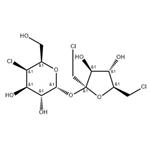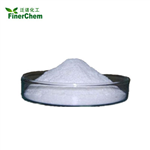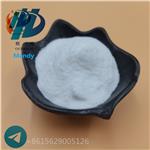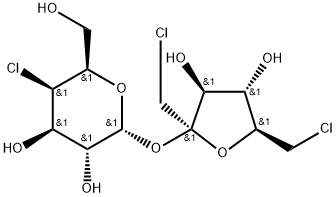- Sucralose
-

- $12.00 / 1kg
-
2024-04-19
- CAS:56038-13-2
- Min. Order: 1kg
- Purity: 99%
- Supply Ability: 5000kg
- Sucralose
-

- $2.00 / 25kg
-
2024-04-19
- CAS:56038-13-2
- Min. Order: 1kg
- Purity: 99%
- Supply Ability: 500mt
- Sucralose
-

- $15.00/ kg
-
2024-04-18
- CAS:56038-13-2
- Min. Order: 1kg
- Purity: 99.912%
- Supply Ability: 10ton
Related articles - Sucralose vs Aspartame
- Sucralose and aspartame are both artificial, high-intensity sweeteners with different properties.
- Oct 11,2023
- Is sucralose safe?
- Sucralose is a zero calorie artificial sweetener. Sucralose is made from sugar in a multistep chemical process in which three ....
- Mar 22,2022
|
| | Sucralose Basic information |
| Product Name: | Sucralose | | Synonyms: | 1-(1,6-Dichloro-1,6-dideoxy-beta-D-fructofuranosyl)-4-chloro-4-deoxy-alpha-D-galactopyranoside;SUCRALOSE(P);Sucralose ,98%;1,6-dichloro-1,6-dideoxy-beta-d-fructofuranosyl4-chloro-4-deoxy-alpha-d-gala;alpha-d-galactopyranoside,1,6-dichloro-1,6-dideoxy-beta-d-fructofuranosyl4-ch;1,6-DICHLORO-1,6-DIDEOXY-BETA-D-FRUCTOFURANOSYL-4-CHLORO-4-DEOXY-ALPHA-D-GALACOTOPYRANOSIDE;1,6-Dichloro-1,6-dideoxy-beta-D-fructofuranosyl 4-chloro-4-deoxy-alpha-D-galactose;SUCRALOSE | | CAS: | 56038-13-2 | | MF: | C12H19Cl3O8 | | MW: | 397.63 | | EINECS: | 259-952-2 | | Product Categories: | Food & Flavor Additives;Ring Systems;Food Ingredients;Food addive,sweeteners;Food additives;HISTOSTAT;Oligosaccharide Compounds;Nutritional Supplements;Sweeteners;Oligosaccharides;Miscellaneous Biochemicals;pharmacetical;56038-13-2 | | Mol File: | 56038-13-2.mol |  |
| | Sucralose Chemical Properties |
| | Sucralose Usage And Synthesis |
| Description | Sucralose is the only non-caloric sweetener made from sugar. It is in fact the latest non nutritive sweetener to have been approved by US FDA and other regulatory bodies and have hit the markets .
Sucralose is derived from sugar through a multi-step patented manufacturing process that selectively substitutes three atoms of chlorine for three hydroxyl groups on the sugar molecule. This change produces a sweetener that has no calories, yet is 600 times sweeter than sucrose, making it roughly twice as sweet as saccharin and four times as sweet as aspartame. | | Chemical Properties | Sucralose is a white to off-white colored, free-flowing, crystalline
powder. | | History | Sucralose, 1,6-dichloro-1,6-dideoxy-β-D-fructofuranosyl- 4-chloro-4-deoxy-α-D-galactopyranoside, is a trichloro-galactosucrose sweetener developed by the British sugar company Tate & Lyle during the 1970s (U.S. Pat. 4,343,934 (Aug. 10, 1982), M. R. Jenner and D. Waite (to Talres Development), (U.S. Pat. 4,362,869 (Dec. 7, 1982), M. R. Jenner and co-workers (to Talres Development), and (U.S. Pat. 4,435,440 (Mar. 6, 1984), L. Hough, S. P. Phadnis, and R. A. Khan (to Tate & Lyle). It was licensed to McNeil-PPC, Inc., a Johnson & Johnson subsidiary, in the United States until a new agreement took place in February, 2004. McNeil Nutritionals retained ownership of SPLENDA Brand and the right for its worldwide retail and food service business. Tate & Lyle became the sole manufacturer of SPLENDA Brand sucralose and owned the right for its worldwide ingredient sales. | | Uses | High intensity sweetener manufactured by replacing three hydroxyl groups on the sucrose molecule with three chlorine atoms. The results are a sweetener of 0 cal that is not digested. It is 600 times as sweet as sugar with a similar flavor profile. It is heat stable, readily soluble, and maintains its stability at elevated temperatures. It has been approved for use in specific categories that include baked products, beverages, confectioneries, and certain desserts and toppings. | | Uses | antiprotozoal | | Uses | Sucralose (1,6-dichloro-1,6-dideoxy-p-fructofuranosyl-4-chloro-oc-
D-galactopyra- noside) is a nonnutritive sweetener based on sucrose. It
is selectively chlorinated and the glycoside link between the two rings
is resistant to hydrolysis by acid or enzymes, so it is not metabolized. It
has 400 to 800 times the sweetness of sucrose, is very soluble in water,
and is stable in heat. It can be used in food products that are baked or
fried.
Sucralose is produced by the selective chlorination of the sucrose molecule
using a patented process by Tate and LyIe that replaces the three
hydroxyl groups (OH) with three chlorine (Cl) atoms.
This modified sugar is minimally absorbed by the body and passes out
unchanged. It was approved for use in foods and beverages in 1999 in
the United States. | | Uses | A low-calorie artificial sweetener | | Definition | ChEBI: A disaccharide derivative consisting of 4-chloro-4-deoxy-alpha-D-galactopyranose and 1,6-dichloro-1,6-dideoxy-beta-D-fructofuranose units linked by a glycosidic bond. | | Production Methods | Sucralose may be prepared by a variety of methods that involve the
selective substitution of three sucrose hydroxyl groups by chlorine.
Sucralose can also be synthesized by the reaction of sucrose (or an
acetate) with thionyl chloride. | | General Description | Certified pharmaceutical secondary standards for application in quality control provide pharma laboratories and manufacturers with a convenient and cost-effective alternative to pharmacopeia primary standards.
Sucralose is a polar, chlorinated sugar synthesized from saccharose precursor. It is widely used as a sweetener in a number of food and beverage products. | | Pharmaceutical Applications | Sucralose is used as a sweetening agent in beverages, foods, and
pharmaceutical applications. It has a sweetening power approximately
300–1000 times that of sucrose and has no aftertaste. It has
no nutritional value, is noncariogenic, does not promote dental
caries, and produces no glycemic response. | | Biochem/physiol Actions | A synthetic sweet tastant detectable by humans. Activates T1R2/T1R3 sweet taste receptors on enteroendocrine cells and elicits increased hormonal secretion of glucagon-like peptide-1 and glucose-dependent insulinotrophic peptide. | | Safety | Sucralose is generally regarded as a nontoxic and nonirritant
material and is approved, in a number of countries, for use in food
products. Following oral consumption, sucralose is mainly unabsorbed
and is excreted in the feces.
The WHO has set an acceptable daily intake for sucralose of up
to 15 mg/kg body-weight.
LD50 (mouse, oral): > 16 g/kg
LD50 (rat, oral): > 10 g/kg | | storage | Sucralose is a relatively stable material. In aqueous solution, at
highly acidic conditions (pH < 3), and at high temperatures
(≤35℃), it is hydrolyzed to a limited extent, producing 4-chloro-4-
deoxygalactose and 1,6-dichloro-1,6-dideoxyfructose. In food
products, sucralose remains stable throughout extended storage
periods, even at low pH. However, it is most stable at pH 5–6.
Sucralose should be stored in a well-closed container in a cool,
dry place, at a temperature not exceeding 21℃. Sucralose, when
heated at elevated temperatures, may break down with the release
of carbon dioxide, carbon monoxide, and minor amounts of
hydrogen chloride. | | Regulatory Status | The FDA, in April 1998, approved sucralose for use as a tabletop
sweetener and as an additive in a variety of food products. In the
UK, sucralose was fully authorized for use in food products in
2005. It is also accepted for use in many other countries
worldwide. Included in the Canadian List of Acceptable Nonmedicinal
Ingredients. |
| | Sucralose Preparation Products And Raw materials |
|